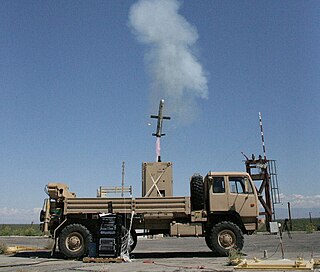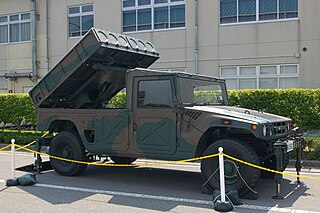The AIM-120 Advanced Medium-Range Air-to-Air Missile(AMRAAM) ( AM-ram) is an American beyond-visual-range air-to-air missile capable of all-weather day-and-night operations. It uses active transmit-receive radar guidance instead of semi-active receive-only radar guidance. When an AMRAAM missile is launched, NATO pilots use the brevity code "Fox Three".

The TomahawkLand Attack Missile (TLAM) is a long-range, all-weather, jet-powered, subsonic cruise missile that is primarily used by the United States Navy and Royal Navy in ship and submarine-based land-attack operations.

The MIM-104 Patriot is a surface-to-air missile (SAM) system, the primary such system used by the United States Army and several allied states. It is manufactured by the U.S. defense contractor Raytheon and derives its name from the radar component of the weapon system. The AN/MPQ-53 at the heart of the system is known as the "Phased Array Tracking Radar to Intercept on Target," which is a backronym for "Patriot". In 1984, the Patriot system began to replace the Nike Hercules system as the U.S. Army's primary high to medium air defense (HIMAD) system and the MIM-23 Hawk system as the U.S. Army's medium tactical air defense system. In addition to these roles, Patriot has been given a function in the U.S. Army's anti-ballistic missile (ABM) system. As of 2016, the system is expected to stay fielded until at least 2040.

The FGM-148 Javelin, or Advanced Anti-Tank Weapon System-Medium (AAWS-M), is an American-made man-portable anti-tank system in service since 1996, and continuously upgraded. It replaced the M47 Dragon anti-tank missile in US service. Its fire-and-forget design features automatic infrared guidance, allowing the user to seek cover immediately after launch, in contrast to wire-guided systems, like the system used by the Dragon, which require a user to guide the weapon throughout the engagement. The Javelin's high-explosive anti-tank (HEAT) warhead can defeat modern tanks by top-down attack, hitting them from above, where their armor is thinnest, and is also useful against fortifications in a direct attack flight.

The RIM-116 Rolling Airframe Missile (RAM) is a small, lightweight, infrared homing surface-to-air missile in use by the German, Japanese, Greek, Turkish, South Korean, Saudi Arabian, Egyptian, Mexican, UAE, and United States navies. It was originally intended and used primarily as a point-defense weapon against anti-ship missiles. As its name indicates, RAM rolls as it flies. The missile must roll during flight because the RF tracking system uses a two-antenna interferometer that can measure phase interference of the electromagnetic wave in one plane only. The rolling interferometer permits the antennas to look at all planes of incoming energy. In addition, because the missile rolls, only one pair of steering canards is required. As of 2005, it is the only U.S. Navy missile to operate in this manner.

The RIM-162 Evolved SeaSparrow Missile (ESSM) is a development of the RIM-7 Sea Sparrow missile used to protect ships from attacking missiles and aircraft. ESSM is designed to counter supersonic maneuvering anti-ship missiles. ESSM also has the ability to be "quad-packed" in the Mark 41 Vertical Launch System, allowing up to four ESSMs to be carried in a single cell.
A surface-to-surface missile (SSM) or ground-to-ground missile (GGM) is a missile designed to be launched from the ground or the sea and strike targets on land or at sea. They may be fired from hand-held or vehicle mounted devices, from fixed installations, or from a ship. They are often powered by a rocket engine or sometimes fired by an explosive charge, since the launching platform is typically stationary or moving slowly. They usually have fins and/or wings for lift and stability, although hyper-velocity or short-ranged missiles may use body lift or fly a ballistic trajectory. The V-1 flying bomb was the first operational surface-to-surface missile.

The AN/MPQ-64 Sentinel is an X-band electronically steered pulse-Doppler 3D radar system used to alert and cue Short Range Air Defense (SHORAD) weapons to the locations of hostile targets approaching their front line forces. It is currently produced by Raytheon Missiles & Defense.

The ADM-160 MALD is an air-launched, expendable decoy missile developed by the United States. It uses gradient-index optics to create a radar cross section that simulates allies' airplane, in order to stimulate, confuse, and degrade the capability of missile defense systems. Later variants (MALD-J) are additionally equipped with electronic countermeasures to actively jam early warning and target acquisition radars.

The Polyphem was a proposed European light-weight fibre-optic wire-guided surface-to-surface missile with a range of 60 km. The project was cancelled in 2003.

The Non-Line of Sight Launch System (NLOS-LS) was a self-contained missile launcher system that was under development by NETFIRES LLC, a partnership between Lockheed Martin and Raytheon. Each Container Launch Unit (CLU) holds 15 missiles, and a self-locating networked communications system. CLUs can be linked for coordinated launching, with the missiles fired and controlled remotely via autonomous vertical launch. The weapon is roughly 2 metres tall.

Spike is an Israeli fire-and-forget anti-tank guided missile and anti-personnel missile with a tandem-charge high-explosive anti-tank (HEAT) warhead. As of 2007, it is in its fourth generation. It was developed and designed by the Israeli company Rafael Advanced Defense Systems. It is available in man-portable, vehicle-launched, helicopter-launched and maritime variants.

The AN/ALE-55 Fiber-Optic Towed Decoy, or ALE-55, is an RF countermeasure under development by BAE Systems Electronic Solutions for the F/A-18E/F Super Hornet.

The AGM-176 Griffin is a lightweight, precision-guided munition developed by Raytheon. It can be launched from the ground or air as a rocket-powered missile or dropped from the air as a guided bomb. It carries a relatively small warhead, and was designed to be a precision low-collateral damage weapon for irregular warfare. It has been used in combat by the United States military during the War in Afghanistan.

The Type 96 Multi-Purpose Missile System (96式多目的誘導弾システム) is an Anti-tank/Landing craft missile used by the JGSDF. It is the first Japanese missile system that uses a complete digitally controlled interface.

ALAS is a Serbian long-range multipurpose wire guided missile system developed by the private company EdePro and the state-owned Yugoimport SDPR. The ALAS missile system was developed primarily for missions against tanks, armored vehicles, fortifications, command posts, low-flying helicopters, coastal ships, industrial facilities and bridges. It can be deployed by any suitable platform including helicopters, armored vehicles, small ships and infantry. The guidance system is based on video/infrared technology, with the missile connected to the launcher by a fiber-optic cable. The ALAS flies at low altitude and has small radar and infrared (heat) signatures due to using a turbofan motor instead of a turbojet. In recent years, the ALAS platform has found a secondary use as a UAV.

HJ-10 is a Chinese ground-launched anti-tank missile developed by Norinco. It has a tandem high-explosive anti-tank (HEAT) warhead, that may penetrate 1,400 mm (55 in) of conventional steel armour protected by explosive reactive armour. The maximum range is 10 km (6.2 mi), with pre- or post-launch lock-on.

FOG-MPM(Fiber Optics Guided Multiple Purpose Missile) is a missile built by the Brazilian company Avibras. Its range is about 60 km. The weight is about 34 kg. Its main use is as an anti-tank, anti-fortification and anti-helicopter missile. FOG-MPM is guided by optical fiber technology. The FOG-MPM is very flexible, can be launched from ground vehicles (Astros II MLRS), ships and helicopters, and is immune to electronic measures.

CM501G is a Chinese land attack missile first revealed during the 9th Zhuhai Airshow held in November 2012. Developed by China Aerospace Science and Industry Corporation (CASIC), CM-501G is also available in air and ship launched versions upon customers' requests, but only the land-based version made its public debut at the airshow.

The Raytheon Coyote is a small, expendable, unmanned aircraft system built by the Raytheon Company, with the capability of operating in autonomous swarms. It is launched from a sonobuoy canister with the wings deploying in early flight phase.


















